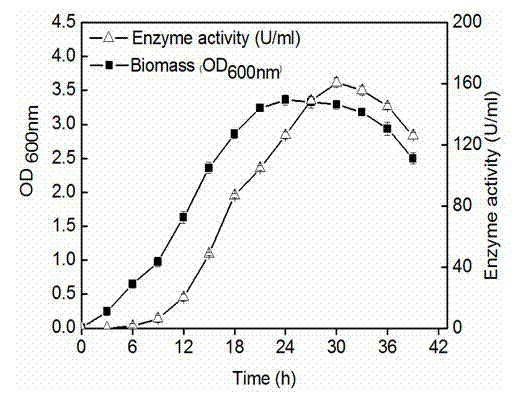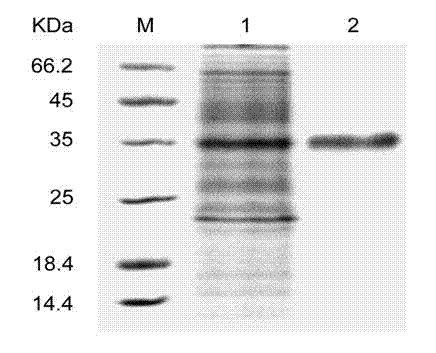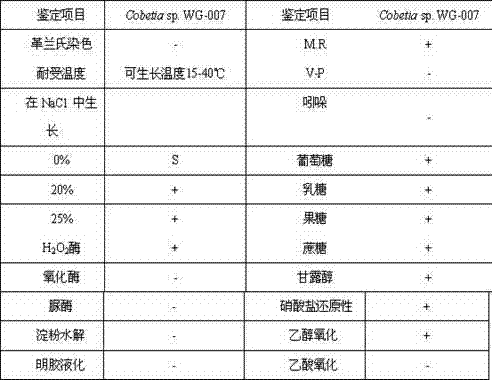Alginate lyase secreted from marine bacterium and preparation method thereof
A technology of alginate lyase and bacterial strain, applied in the field of alginate lyase and its preparation
- Summary
- Abstract
- Description
- Claims
- Application Information
AI Technical Summary
Problems solved by technology
Method used
Image
Examples
Embodiment 1
[0023] Example 1: bacterial strains Cobetia Isolation of sp. WG-007
[0024] The present invention obtains soil samples and waste samples from domestic chemical plants producing sodium alginate. Sodium alginate was used as the sole carbon source to screen high-yielding alginate lyases. Weigh 1.0-1.5 g of soil samples in the media of different concentrations of sodium alginate, ferment and culture at 25 °C for 40 h, take 200 μl of the diluted solution and spread it on the screening solid medium, and culture at 25 °C for 16-18 h , Pick a single colony that can grow on a sodium alginate plate and inoculate it into a fresh self-made liquid medium for 20 h, then inoculate the cell liquid culture at a 1% (w / v) inoculum in a 50 mL fermentation medium In a 250 mL Erlenmeyer flask with a base, shake culture at 25 °C at a speed of 150 r / min, collect the fermentation broth after 40 h, and centrifuge at 8000-12000 r / min for 20-30 min to remove the bacteria, collect the supernatant, and...
Embodiment 2
[0025] Example 2: Strains Cobetia Molecular biological characterization of sp. WG-007
[0026] Strain WG-007 was inoculated in the growth medium, and after culturing for 30 h, part of the fermentation liquid was taken in a 1.5 mL sterile centrifuge tube, and the genome of the bacteria was extracted using a bacterial genome rapid extraction kit, and the genome was used as a template Amplifies the 16S rRNA gene sequence. The PCR reaction conditions were: pre-denaturation at 94 °C for 5 min; denaturation at 95 °C for 45 s, annealing at 55 °C for 60 s, and extension at 72 °C for 60 s; after 30 cycles, post-extension at 72 °C for 10 min.
[0027] The obtained PCR product was purified by tapping recovery kit (Axygen) and ligated with TA cloning vector. After the ligation solution was transformed into competent cells, positive clones were picked and sequenced by Sangon Bioengineering (Shanghai) Co., Ltd. The 16S rDNA sequence of strain WG-007 is 1508 bp in length. The sequence inf...
Embodiment 3
[0028] Example 3: Morphology and Physiological Characteristic Identification of Bacterial Strain WG-007
[0029] The strain is short rod-shaped, round-ended and arranged individually. Gram staining is red, and after being cultured on the plate for 24 hours, the colony is round, with a diameter of about 2-3mm, smooth surface, moist, neat edges, the same color on both sides, slightly raised, and beige in color. No flagella, no sporulation. Biochemical characteristics: Gram staining is negative. The strain can grow under the condition of salt concentration of 30%, and the growth temperature is 15-40°C, but the optimum growth temperature is 25°C, and the optimum NaCl concentration is 6.0%. Catalase is positive, oxidase is negative, M.R is positive, V.P reaction is negative, glucose, lactose, mannitol, etc. can be used; starch and gelatin cannot be hydrolyzed; it has physiological and biochemical characteristics such as nitrate reduction.
PUM
| Property | Measurement | Unit |
|---|---|---|
| molecular weight | aaaaa | aaaaa |
| molecular weight | aaaaa | aaaaa |
Abstract
Description
Claims
Application Information
 Login to View More
Login to View More - R&D
- Intellectual Property
- Life Sciences
- Materials
- Tech Scout
- Unparalleled Data Quality
- Higher Quality Content
- 60% Fewer Hallucinations
Browse by: Latest US Patents, China's latest patents, Technical Efficacy Thesaurus, Application Domain, Technology Topic, Popular Technical Reports.
© 2025 PatSnap. All rights reserved.Legal|Privacy policy|Modern Slavery Act Transparency Statement|Sitemap|About US| Contact US: help@patsnap.com



